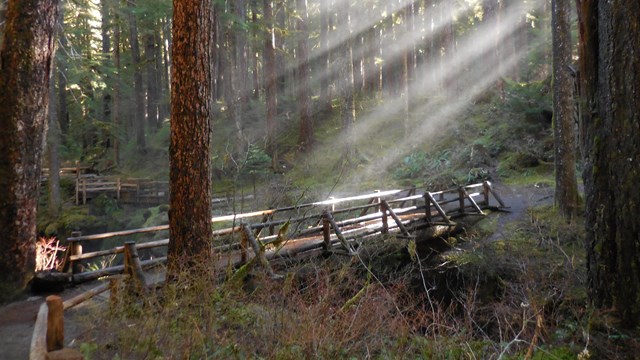Sol Duc Falls Trailhead
Sol Duc River: A Cascading Paradise for Adventure and Relaxation
 `
`
Level of Difficulty
Distance: 0.08 miles one way, Elevation gain: 200 feet,
The Sol Duc Falls Trail is a beloved path for hikers of all skill levels and is good for beginners. The well-maintained trail gently winds alongside the river, offering breathtaking views of cascading waterfalls and emerald pools.
Finding the Trailhead
Driving distance from the home: 50.2 miles, 1 hour, 7 minutes
Lands: Olympic National Park
Google Maps Turn right from the driveway and return to Highway 101 going east toward Lake Crescent. Before you get to Lake Crescent you will make a right hand turn to Sol Duc Hot Springs Road, go 13.8 miles, pass Sol Duc Hot Springs and continue to the trailhead. The parking lot is quite large and tends to fill up quickly during the summer months so you may want to go early to avoid crowds.
Hiking the Trail
You may notice a sign at the trailhead that proclaims the trail name to be SOLEDUCK. Before 1992 the accepted spelling was "Soleduck". In 1992 the spelling was officially changed to "Sol Duc" by the State of Washington Board on Geographic Names. The name comes from its Quileute name, /só:liɬt'aqʷ/, meaning "sparkling waters."
The trail also leads to Deer Lake (4 miles) and Lunch Lake via Deer Lake (8 miles) for nice add-on hikes for the day.
Sol Duc Falls Trail isn't just any cascade, it's a three-pronged trident splitting the waters of this sparkling jewel winding through the heart of Olympic National Park in Washington State. Crystal-clear water cascading over moss-covered rocks, lush rainforests teeming with life, and the invigorating scent of pine filling the air. Chinook and coho salmon ascend the Sol Duc in late summer and spawn in late fall, while cutthroat trout and steelhead run in the fall and winter and spawn in the spring. All of these anadromous fish are born in the Sol Duc River but spend most of their lives in the Pacific Ocean before returning home to spawn. If you time your visit right, you will see fish attempting to jump the falls.
There are several well-built foot bridge crossings over cascading creeks along the way providing beautiful vistas to take pictures. As you near the falls, you will see a small shelter. It is the last remaining trail shelter built in the park by the Civilian Conservation Corps (CCC) from Camp Elwha. The shelter was built in 1939, shortly after Olympic National Park was established from the U.S. Forest Service-administered Mount Olympus National Monument. Two similar shelters were built at Moose Lake and Hoh Lake, neither of which survive. The one-story log structure is T-shaped, with a projecting front porch crowned by a small cupola. The shelter is open to the front porch.
There is a bridge and observation decks at the falls providing fantastic angles to observe and photograph the falls. During high water flows the observation area can become very misty due to the power of the water.
Sol Duc Hot Springs Resort
On your way to the trailhead you passed the Sol Duc Hot Springs Resort, which offers a unique way to unwind after a day of adventure. Imagine soaking in the natural mineral pools, surrounded by lush greenery and the soothing sounds of flowing water. These mineral-rich waters, ranging from 99°F to 104°F in different pools, have been revered for their therapeutic properties for centuries. Let your worries melt away as you immerse yourself in the warm, rejuvenating waters. The resort offers day use passes and towel rental. At the time of publishing the rates were $18 per 1.5 hour session and $12 for kids and seniors, and is open from May to September.
Restrictions and Tips
This is Olympic National Park so the usual restrictions apply, no pets, weapons or vehicles.